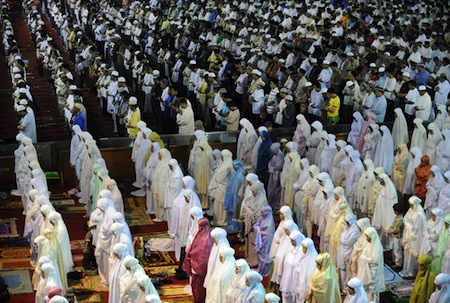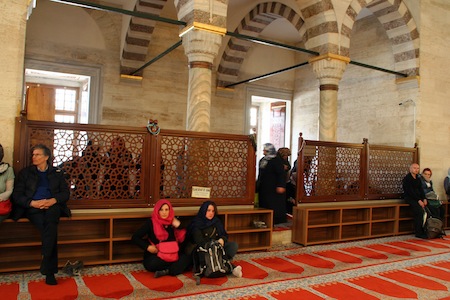“Mommy, why are the women in the back?” my daughter asked me when she was just three years old. I wasn’t prepared for this. The truth is I had been hoping that she wouldn’t ask me because I wasn’t convinced that the women should be behind the men during prayer. I also knew that it wasn’t a requirement for congregational prayer. I felt conflicted because I wanted my beautiful, brilliant little girl to come to love prayer and praying in congregation.
I wanted her to absorb the etiquette of prayer, imbibing its peace, humility, grace, mindfulness towards God, and connection with others. I wanted her to see and feel others relying on God for happiness and purpose. I knew, yet I did not want to acknowledge, that I had to pay the price of accepting to pray with the women (in the back) if I wanted us to have access to all the benefits of congregational prayer. And yes, it does leave a sad feeling in my heart.
I stumbled through an answer that didn’t feel entirely comfortable: “Muslims try to follow the example of the Prophet Muhammad and his companions as much as possible, and this is just the way they did it back then.” I added that not all mosques were this way but most of them are. I felt discontented with my answer, but those were innocent days when she just loved sitting in my lap and hearing my voice tend to her. It really didn’t matter what I said; what mattered was that I was acknowledging her inquisitiveness and was happy to be with her. Now she is nine years old and is naturally and gradually seeking out some independence, and I can’t say with any degree of confidence that she has absorbed all that I wanted her to absorb with regard to congregational prayer. There are two significant times when she prays in a large congregation: every Saturday at the mosque after school and at the Muslim Youth Camp in California. These two settings are very different.

At the Muslim Youth Camp, I have had the opportunity to shape its environment as a board member of the camp. Last year under a huge oak tree, we placed a low bench as a divider between the men (on the left) and women (on the right). When the first adhan was called, several boys automatically sat in the front rows on both sides. (I wondered what they thought the divider was for!) It is natural that they would assume they could occupy the space up front. Being one of the camp directors, I had the authority to move them. I did, and they looked very confused. I think they were just as confused to have a woman tell them something regarding prayer as they were that women would be in the front. A couple of younger boys expressed consternation at the new arrangement, but I knew it was simply because it was unfamiliar to them not because of some ideological commitment on their part. It only takes a decade to set a precedent, which becomes the benchmark for normative behavior for a whole new generation. My impression is that after the first reconfiguration, the side-by-side setup really didn’t matter to the men and boys.
Meanwhile, many of the women and girls were very excited about the change; my friend was enthusiastic about the new arrangement at the camp and was the only adult woman to join me in the front row. As she sat next to me, she said, “When I was growing up in Saudi, this is the way we used to do it! All the mosques were like this: the women and men side by side.” Another auntie told me years ago that the first time she saw women praying behind the men was when she emigrated from Iran to the United States. (Can you imagine? We put women in the back in the U.S.!) I went to the front row for nearly every prayer just because I knew that the others wouldn’t do it without an authoritative figure giving them “permission” to do so. I was surprised at how many young women were comfortable in the back. Being that most of them were teenagers, it is not surprising that many of them chose to blend in and did not want to put themselves front and center. Of course, it was also advantageous to sit in the back when they didn’t want to pay attention to any lesson being taught before or after the prayer. Then there’s the consideration that conformity is the antithesis of individualism that characterizes American teenage years. Congregational prayer is conformity. There was bound to be some resistance to it.

Amira Quraishi is currently and Instructor at Swarthmore College, teaching courses on Islam. She is a PhD candidate at the University of Pennsylvania in Religious Studies, where her dissertation research is on the intersections between Islamic law and Sufism. She has been on the Board of the Muslim Youth Camp of California since 2005 and its Head Counselor since 1995. She has also been the Advisor to the Johns Hopkins University Muslim Association and on the Interfaith board of chaplains there. She is happily married, raising two daughters with her husband, Husam Ansari.




As-Salam ‘Alaykum. I miss MYC Camp. The part about the boys rushing to sit on both sides of the bench literally made me laugh out loud 🙂 It’s also interesting that kids can ask questions that force adults to think really hard. Finally, I really like the point about how the most important aspect of prayer, connection to God, often gets lost in the discussion because people are so fired up about other issues like where people should stand and how they stand. Great article Asifa!!! Peace.
I agree that the Muslim community needs to come to grips with the 21st century. However, I also believe that Sunnah does not mean that something is optional. The way of the Prophet Muhammad (saws) is always the best path to Jannah. If there are excruciating circumstances, then men and women can pray side by side, as the schools of thought, with the exception of the Hanafi madhab, state that the prayer is valid.
But is “valid” good enough for the Muslim community? And what would be the excruciating circumstances at a camp be that would require men and women to forego the Sunnah?
Undoubtedly the Sunnah is for the women???s rows to be behind the men, as was the case at the time of the Prophet (peace and blessings of Allaah be upon him). Al-Bukhaari (380) and Muslim (658) narrated from Anas ibn Maalik (may Allaah be pleased with him) that his grandmother Mulaykah invited the Messenger of Allaah (peace and blessings of Allaah be upon him) to a meal that she had made for him, and he ate some, then he said: ???Get up and let me lead you in prayer.??? Anas said: I went and got a reed mat of ours that had become blackened from long use, and sprinkled it with water. Then the Messenger of Allaah (peace and blessings of Allaah be upon him) stood, and the orphan and I stood behind him, and the old lady stood behind us, and the Messenger of Allaah (peace and blessings of Allaah be upon him) led us in praying two rak’ahs, then he left.
Al-Haafiz said in al-Fath: This hadeeth teaches us a number of things?? that women should stand behind the men???s rows, and a woman should form a row on her own if no other woman is present.
I would also like to add that even in situations where the women had to pray to the side of the men, it is still the Sunnah that the young girls would pray in the front rows and then women would pray in the back rows. Prophet Muhammad (alayhi Salat wa salam) has said, “Pray as you see me pray”. As that was the precedent, that is what should be followed, unless there are excruciating circumstances. For example, if the congregation was praying in an area in which the ground had a slope and it would be dangerous for the women to pray in that area, they can be moved to the side of the men, with a barrier. But since a campsite has ample space, I don’t see how that would be a necessity. Wallahu ‘Alim.